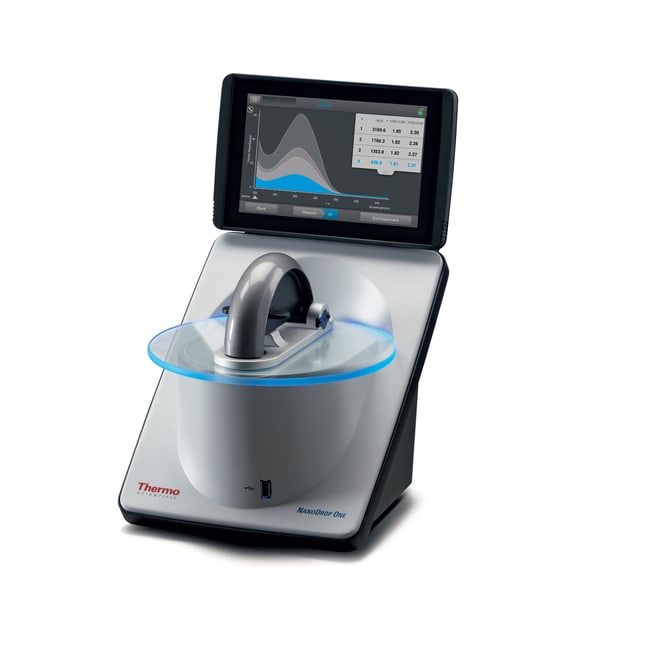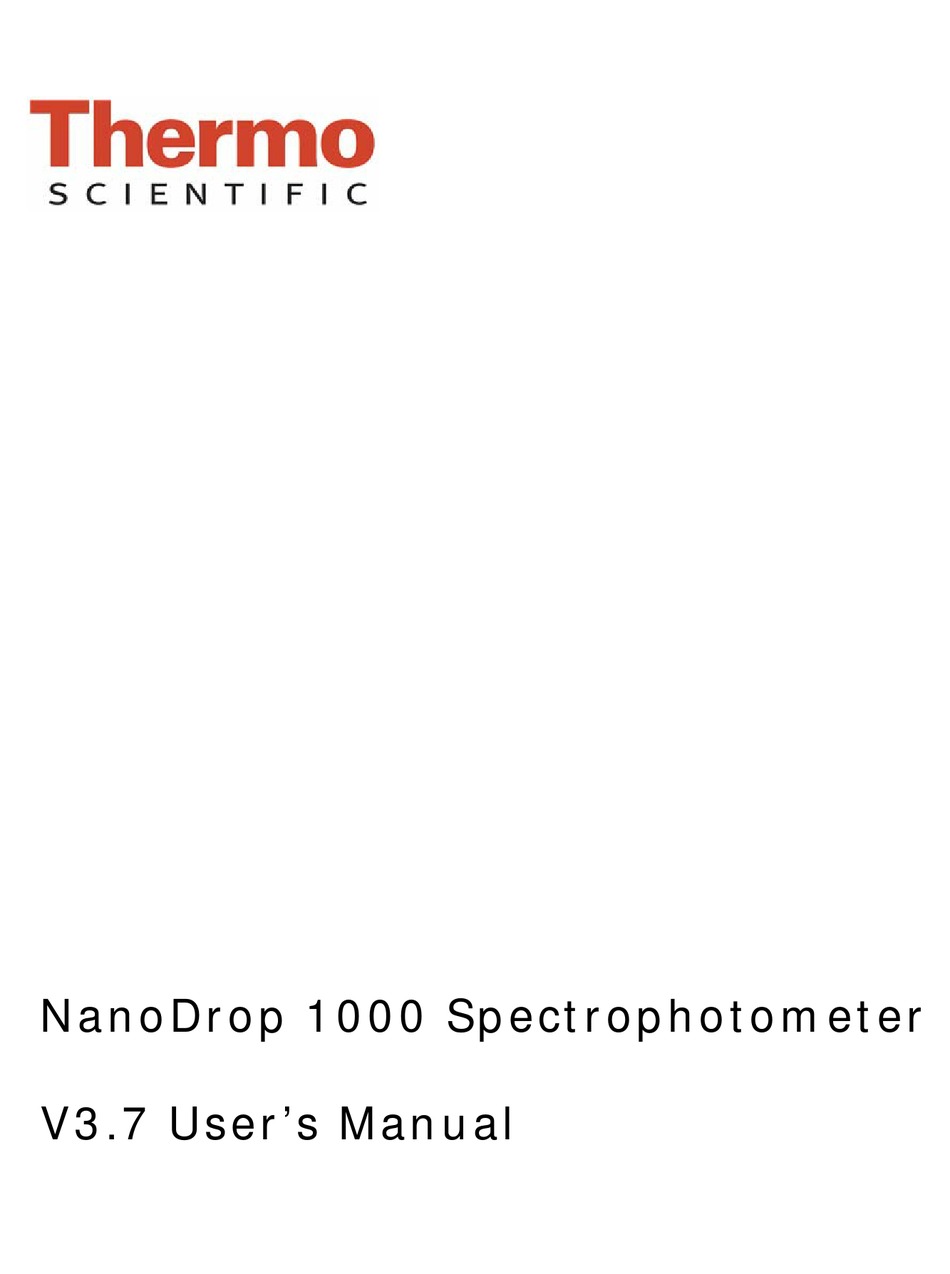1) measuring protein concentration ( further information in manual page 8- 1): nanodrop nd- 1000 double click on the icon labeled nd- 1000 spectrophotometer on the desktop to open the software. The nanodrop spectrophotometer contains no user serviceable parts; do not open. This eliminates the need. Beginning December 31, 2016, the ND-1000 will become obsolete, which means that we will only offer limited support (no software updates, only commercially-viable service, and reduced availability of replacement parts). We now offer the Thermo Scientific™ NanoDrop™ One microvolume spectrophotometer, the newest member of the NanoDrop family.
Websites
- General FAQ http://nanodrop.com/library/ND%201000%20FAQ.pdf
- User Manual http://nanodrop.com/Support.aspx?Type=User%20Guides&Cat=NanoDrop%201000
- Reproducibility Performance Data http://www.nanodrop.com/library/NanoDrop%201000-Reproducibility-Performance-Data.pdf
- Linearity Performance Data http://www.nanodrop.com/library/NanoDrop%201000-linearity-Performance-Data.pdf
- Homogeneity Performance Data http://www.nanodrop.com/library/NanoDrop%201000-Homogeneity-Performance-Data.pdf
- NanoDrop Website http://www.nanodrop.com

Procedure

- Before starting the software module, clean the sample surfaces with DI water to remove any dried sample that might be present.
- Alternatively, you can clean the sample surfaces with a Kimwipe moistened with 70% ethanol.
- Open the Nanodrop program and the appropriate module (e.g., DNA).
- Wipe off the top and bottom sensors of the instrument with a Kimwipe. These are just the polished ends of fiber optic cable, so wiping is sufficient to prevent carryover.
- Pipette 2 μL of DD water (stored in a blue microtube) onto the sensor. Bring down the lever arm.
- Follow the onscreen prompts to calibrate.
- Wipe the sensors and pipette on 2 μL of the corresponding blank (Buffer EB or whatever solution your prep is in). Bring down the lever arm.
- Follow the onscreen prompts to blank.
- Wipe the sensors and pipette on 2 μL of your sample. Bring down the lever arm.
- Click Measure and record the concentration measured.
- For DNA, the peak should be at 260 nm, and as a general rule, the 260/280 ratio should be between 1.8 and 2.0.
- To test multiple samples, just wipe the sensor in between measurements with a Kimwipe. Recalibration or re-blanking is not necessary.
- Clean the sample surfaces once more after you are finished.
Notes
Measurement volume - 1 vs 2 µl
If your sample volume is very low, you may want to measure 1µl instead of the recommended 2µl. In my hands, however, this doubles the measurement error from about 0.5% to 1% standard deviation/mean. These figures are from repeated measurement of 2 RNA samples, which resulted in 3.5ng/µl SD for a mean of 689ng/µl (2µl volume) vs. 9.2ng/µl SD for a mean of 778ng/µl (1µl), n=5. -- Jakob 2009/7
Liquid column not formed
If you see that a liquid column is not being formed, the surfaces may have been un-conditioned by protein or surfactants. Rub each surface 15-20 times with a dry Kimwipe to buff. Using 2 μL samples should ensure the formation of a column.
Nanodrop gives strange readings

Occasionally, the Nanodrop can give strange readings. One method to help prevent against this is (after you blank the instrument and wipe the sensor) to pipette on 2 μL of your blank once more and click measure. Then verify that the absorbance is at or near 0 for all wavelengths. If it is not, reclean the sensor and start again. Perhaps this effect is due to a liquid column not being formed?
Nanodrop freezing - cable problems
We had issues of the Nanodrop freezing up sporadically during measurement such that the software became completely unresponsive and the machine was stuck in a measurement state. Tech support responded and said that static discharge can interfere with the computer/machine connection. They had previously sent out a batch of cables which were defective. The USB cable should be white not black. If your USB cable is black, you should probably call them up and ask for a replacement. --Austin 15:17, 18 April 2006 (EDT)
Lab Nanodrop pages
FAQ
Question
How does the Nanodrop convert A260 to concentration in ng/uL?
Answer
From the nanodrop user manual (download at http://nanodrop.com/Support.aspx?Type=User%20Guides&Cat=NanoDrop%201000 )
- General
The Beer-Lambert equation is used to correlate the calculated absorbance with concentration:
A = E * b * c
Where A is the absorbance represented in absorbance units (A), E is the wavelength-dependent molar absorptivity coefficient (or extinction coefficient) with units of liter/mol-cm, b is the path length in cm, and c is the analyte concentration in moles/liter or molarity (M).
- For nucleic acid quantification, the Beer-Lambert equation is manipulated to give:
c = A/(E * b)
Where c is the nucleic acid concentration in ng/microliter, A is the absorbance in AU, e is the wavelength-dependent extinction coefficient in ng-cm/microliter and b is the path length in cm. The generally accepted extinction coefficients for nucleic acids are:
• Double-stranded DNA: 50
• Single-stranded DNA: 33
• RNA: 40
For the NanoDrop® ND-1000 Spectrophotometer,paths of 1.0 mm and 0.2 mm are used compared to a standard spectrophotometer using a 10.0 mm path. Thus, the NanoDrop® ND-1000 Spectrophotometer is capable of measuring samples that are 50 times more concentrated than can be measured in a standard spectrophotometer.
Note: absorbance data shown in archive files are represented as displayed on the software screen. For Nucleic Acid, Protein A280 and Proteins and Labels modules, data are normalized to a 1.0 cm (10.0 mm) path. For MicroArray, UV-Vis, Protein BCA, Protein Bradford, Protein Lowry and Cell Culture modules the data are normalized to a 0.1 cm (1.0 mm) path. For high absorbance UV-Vis samples, data are normalized to a 0.1mm path.
Other References
- The Biopolymer Calculator (http://paris.chem.yale.edu/extinct.html) calculates the extinction coefficient of nucleic acid sequences using an established base composition and nearest neighbor algorithm.
Comparing concentrations obtained with the calculated extinction coefficient vs. the nanodrop constant:
Calculated concentration was ~20% lower for two RNA sequences (subtillis pheB and BBa_I7101 mRNA) ~~cmc 11:13, 2 Jun 2005 (EDT)
- http://www.owczarzy.net/extinct.htm For more information on algorithms for calculating extinction coefficients.
- Warshaw, Ph.D. Thesis, University of California, Berkeley, 1965
- Warshaw and Tinoco, J. Mol. Biol., 20, 29 (1966)
- Cantor and Warshaw, Biopolymers, 9, 1059 (1970)
- Molecular Cloning, Third Edition, A8.19 on Quantitation of Nucleic Acids:
Suggests that for short oligos it is important to calculate the extinction coefficient of a sequence of interest, but that for large molecules the following average extinction coefficients should be used:dsDNA: 50 (uG/ml)-1
ssDNA or RNA: 38 (uG/ml)-1
Question
When you are measuring the concentration of DNA at 260 nm, the softwareautomatically compensates for the fact that you are measuring your sample at a 1 mm path length instead of the standard 1 cm pathlength. For cell culture at OD 600 nm, the software does not do the same thing. Instead it displays the 1mm absorbance. Why?
Answer
This answer was received in an email response from an Application Scientist at Nanodrop Technologies, Inc.
'Yes, the Cell Cultures module is currently displayed at 1 mm and not 10 mm.
Note: absorbance data shown in archive files are represented as displayed onthe software screen. For Nucleic Acid, Protein A280 and Proteins and Labelsmodules, data are normalized to a 1.0 cm (10.0 mm) path. For MicroArray,UV-Vis, Protein BCA, Protein Bradford, Protein Lowry and Cell Culturemodules the data are normalized to a 0.1 cm (1.0 mm) path. For highabsorbance UV-Vis samples, data are normalized to a 0.1mm path.
Regarding microbial cell cultures in suspension:
The short answer: The ND-1000 can be used to estimate bacterial growthcultures, and any limitations will be similar to limitations of otherspectrophotometers.
The long answer: The fundamental issue surrounding bacterial culture growthmeasurements is that an absorbance spectrophotometer is being asked todetermine light scattering caused by particulates in suspension. In thiscase, transmittance is not related to absorbance in the classical sense.Under normal true absorbance conditions, spectrophotometers can becomparable to one another because the sample actually absorbselectromagnetic energy. In the case of a reduction of transmittance causedby light scattering, readings are very dependent on the optics of a specificspectrophotometer as well as the cell type in suspension. For bacterialgrowth determination, even 1cm path length systems can vary greatly due tothe variability of the optics of each system. The ND-1000 will display an'absorbance' value approximately 10 fold less than 1cm systems due to thefact that the instrument is utilizing a 1mm path length. However, thedifference will not be exactly 10 fold due to the reasons I've describedabove. The point is that the differences between the ND-1000 and a'conventional' spec (apart from the 10 fold difference due to path length),will be similar to differences found between spectrophotometers that utilizea 1cm path length.'

Videos

- Nanodrop it like it's hot! by Brown iGEM
The neat nd-1000 software is developing at a frantic pace. New versions of the software should be released several times a quarter and even several times a month.
Update for neat nd-1000 software.
Nanodrop Nd 1000 Software Mac Version
There are several reasons for this dynamic:
First, new technologies are emerging, as a result, the equipment is being improved and that, in turn, requires software changes.
Secondly, the needs of users are growing, requirements are increasing and the needs are changing for neat nd-1000 software.
Therefore, it is necessary to monitor changes in the neat nd-1000 software and to update it in a timely manner.
Nanodrop Spectrophotometer Nd-1000 Software
/ If you do not update
There are many sources for obtaining information on software.